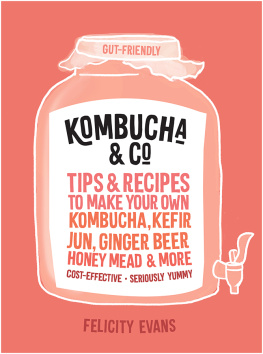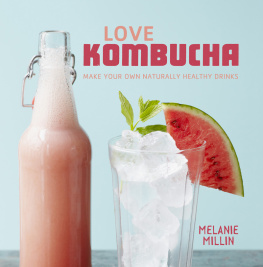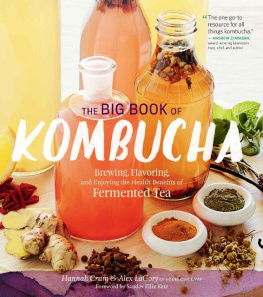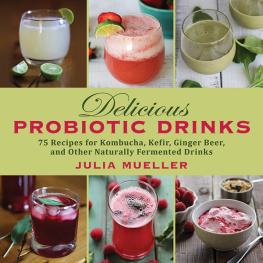Kombucha Rediscovered
The Medicinal Benefits of an
Ancient Healing Tea
Revised Edition
Klaus Kaufmann, DSc
Books Alive
Summertown, TN

2013 Klaus Kaufmann
Cover and interior design: Deirdre Nemmers
Cover photography: Andrew Schmidt and Liz Murray
All rights reserved. No portion of this book may be reproduced by any means whatsoever,
except for brief quotations in reviews, without written permission from the publisher.
Books Alive, an imprint of Book Publishing Company
PO Box 99
Summertown, TN 38483
888-260-8458
bookpubco.com
ISBN 13: 978-0-920470-84-8
19 18 17 16 15 14 13 1 2 3 4 5 6 7 8 9
Printed in The United States of America
Library of Congress Cataloging-in-Publication Data
Kaufmann, Klaus N., 1942
Kombucha rediscovered! : the medicinal benefits of an ancient healing tea / Klaus Kaufmann. -- Revised edition.
pages cm
Includes bibliographical references and index.
ISBN 978-0-920470-84-8 (pbk.) -- ISBN 978-0-920470-76-3 (e-book)
1. Kombucha tea. 2. Tea fungus--Therapeutic use. I. Title.
RM666.T25K38 2013
615.321--dc23
2012038851

Book Publishing Company is a member of Green Press Initiative. We chose to print this title on paper with 100% postconsumer recycled content, processed without chlorine, which saved the following natural resources:
17 trees
541 pounds of solid waste
8,077 gallons of water
1,489 pounds of greenhouse gases
7 million BTU of energy
For more information on Green Press Initiative, visit www.greenpressinitiative.org. Environmental impact estimates were made using the Environmental Defense Fund Paper Calculator. For more information visit www.papercalculator.org.
To my devoted mother, who brewed
the tastiest tea in the world.
I suppose I ought to eat or drink something or other; but the great question is, what? Alice looked all round her at the flowers and the blades of grass, but she did not see anything that looked like the right thing to eat or drink under the circumstances. There was a large mushroom growing near her, about the same height as herself; and when she had looked under it, and on both sides of it, and behind it, it occurred to her that she might as well look and see what was on the top of it.
Lewis Carroll, Alices Adventures in Wonderland

Contents
The role of the infinitely small in nature is infinitely great.
Louis Pasteur
Foreword
Hardly a day goes by at the Wild Rose College of Natural Healing or clinic that someone doesnt phone to ask a question about kombucha tea, which callers also may refer to as that mushroom tea or maybe that pancake mushroom tea. Given the current level of interest, the timing couldnt be more appropriate for an informative book about this healing tea.
Is the tea just a fad? Kombucha teas popularity has come and gone over the centuries. Knowledge of it goes back at least two thousand years, a substantial span of time, I think, that clearly indicates that kombucha tea is here to stay. How, then, should we describe it? Is it food from the gods? Is it a panacea? Can it cure conditions as diverse as arthritis, baldness, and cancer? I hope youll find answers to such questions, and many more, in this book.
While commercial brands of kombucha tea can be purchased in some natural food stores, the tea is most often brewed at home. With each fresh batch, a new kombucha culture or baby is formed, making it possible for home brewers to pass along new cultures to family members and friends. Because brewing kombucha tea involves microorganisms, careful handling of the kombucha culture is a must, as is using proven methods, like those described in this book, when making the tea at home. These are probably the most important considerations related to the tea.
Is kombucha tea safe for everyone? Many practitioners have suggested that people who have an impaired or weakened immune system should avoid the tea. Others recommend that people who have yeast infections shouldnt use the tea. In addition, some have cautioned people with diabetes against using the tea because of its potential sugar content. However, since all kombucha teas dont contain the same strains of bacteria and yeast, and because brewing time largely determines the sugar content in the final product, these concerns may apply to some teas but not to others.
I believe well be hearing many more reports of healing agents coming from such microorganisms as bacteria, yeast, and fungi. Although I dont believe that any medicinal substance can in itself cure an ailment, I heartily acknowledge that some substances can help us on the way to a better quality of life. This includes the medicinal use of microorganisms, which isnt a new approach. Many mainstream antibiotics, for example, were derived from microorganisms. In addition, some people introduce friendly bacteria, such as acidophilus, into their diets in the form of yogurt or supplements, because having a proper ecological balance of microorganisms in the gut can be so important in determining ones overall state of health.
As time goes on, the mystery about kombucha tea will be solved; science will reveal explanations for the teas functional effects on human physiology. In the meantime, if you want to become a kombucha tea drinker or brewmaster, or are simply curious about what kombucha tea is, this book is a good place to start.
Terry Willard, PhD
Wild Rose College of Natural Healing
and Wild Rose Wholistic Clinic
Publishers Note to the First Edition
The modern age dawned and with it came the nightmare of modern food preparation. Refrigeration, pasteurization, canning, processing, and freezing may be convenient in our fast-paced society, but these methods have made our food base devoid of nutrition. All of these commonplace practices rob food of its vitamins, minerals, enzymes, and essential fatty acids. As a result, we have seen a dramatic increase in the frequency of such frightening diseases as cancer, and people are plagued with chronic diseases of the bowels, stomach, and liver. Poor nutritionand thus poor healthhas led people to search for alternative methods of food preparation. Often, these seekers simply rediscover ancient practices.
Lately, there has been renewed awareness of the benefits of lactic acid-fermented foods. Lactic acid fermentation is the oldest-known method for preserving food. To keep fruits and vegetables for the winter, our ancestors fermented them and stored them underground in storage cellars, which, unlike our modern basements, were not sealed from moisture and air. Many of the other staples in our ancestors diets were preserved and stored in this manner. Whole, raw, and unrefined foods were stored with such fermented foods as sourdough bread, kefir, cured meats, and natural cheeses. These foods provided the nutritional foundation for an active life. Today, however, according to postindustrial perspectives about nutrition, these forms of food preparation and storage are considered primitive and tedious. Yet, such common and ancient practices cant be dismissed so easily. Luckily for us, fermented foods are coming back into fashion.













